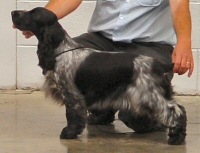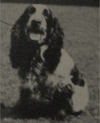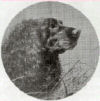Breed History
It is generally thought that the word spaniel derives from the word Espagnol meaning Spanish, the land from where all of the Spaniel breeds are believed to hold their origins. Although current research suggests that the Spaniel, while European came from everywhere and nowhere. It is a European morphological type, suited to canine "Spaniel" type instinct and human purpose through the ages.
The earliest mention of Spaniels to be found in English literature is contained in the celebrated " Master of Game," the work of Edward Plantagenet, second Duke of York, and Master of Game to his uncle, Henry IV., to whom the work is dedicated. It was written between the years 1406 and 1413. ...His chapter on Spaniels, however, is mainly a translation from the equally celebrated " Livre de Chasse," of Gaston Comte de Foix, generally known as Gaston Phoebus, which was written in 1387, so that we may safely assume that Spaniels were well known, and habitually used as aids to the chase both in France and England, as early as the middle of the fourteenth century.
Dogs and all about them. 1910. Leighton, Robert. Chapter XXVI. The Sporting Spaniel. Cane, Colonel R. Claude.
(Of St. Wolstans, Kildare.)
Initially described as either land or water spaniels, later they were divided based on hunting ability, task and size.
There be gentle dogs serving the hawk, and first of the Spaniel, called in Latin Hispaniolus. There be two sorts, viz.; the first findeth game on the land ; the other findeth game on the water.
Of Englishe dogges. 1576. Caius, Dr. John.
The Cocker can scarcely be described, in as much as there are so many varieties in different parts of Great Britain. He may however be said, in general terms, to be a light, active Spaniel, of about fourteen pounds weight on the average, sometimes reaching twenty pounds, with very elegant shape, a lively and spirited carriage. In hunting he keeps his tail down, like the rest of his kind, works it constantly in a most rapid and merry way; alone he may be known from the Springer, who also works his, but solemnly and deliberately, without the same pleasurable sensations which are displayed by the Cocker. The head is round and the forehead raised; muzzle more pointed than the Springer, and the ears less heavy, but of good length and well clothed with soft, wavy hair, which should not be matted in a heavy mass. The eye is of medium size, slightly inclined to water, but not to weep like the toy dog's; body of medium length, and the shape generally resembling that of a small Setter. These dogs are well feathered, and the work for their feet and legs requires them to be strong and well formed. The coat should be thick and wavy, but not absolutely curled, which last shows the cross with the Water Spaniel, and that gives too much obstinacy with it to conduce to success in covert shooting. The colour varies from plain liver or black to black and tan, white and black, white and liver, white and red, or white and lemon.
The dogs of the British Islands. 1882. Walsh, John Henry. "Stonehenge".
The modern evolution of the Cocker also involves the ancestry of many of today's modern Spaniel breeds and some that have faded into history. It must be said the name "Cocker" derives from the suitability of the breed to flush Woodcock and small game for hunting and it is as a Gundog the breed was first established until defined by the Kennel Club.
The first stud book of the English Kennel Club divided the Spaniel dogs by weight alone. English Cockers fell into the small land spaniel group. If a spaniel weighed under 25 lbs, it was called a Cocker Spaniel. If a spaniel weighed over 25 lbs, it was called a Field Spaniel. Problems existed with the weight designations, so it was decided that type should be considered more important than weight.
...a limit arbitrarily and somewhat irrationally fixed, since in the case of an animal just on the border-line he might very well have been a Cocker before and a Field Spaniel after breakfast.
Dogs and all about them. 1910. Leighton, Robert. Chapter XXVI. The Sporting Spaniel. Cane, Colonel R. Claude.
The Kennel Club separated the different types of spaniels in the Stud Book by 1893. In the United States of America, Cocker registrations can be traced to 1879.
In researching the pedigree of the modern cocker, when we dig back far enough, we happen on the names of the breeders that shaped the Cocker Spaniel as we know it. Mr. W. W. Boulton of Beverley, Mr. Phineas Bullock of Bilston, Sir. Francis Burdett, Mr. James Freme of Flintshire, Mr. Footman of Lutterworth, Mr. James Farrow of Ipswitch, Mr. George Jones of Oscott, Mr. Mousley, Mr. Chester Arthur Phillips (Rivington), Mr. J. M. Porter (Braeside), Mr. Richard Lloyd and his son Mr. Herbert Summers Lloyd MBE (of Ware) and Dr. J. H. Spurgin of Northhampton have all had spaniels that influenced the genetic makeup our little friends today.
Many famous kennel lines have filled the intervening years to where we are now; - including a healthy portion from Ireland. Akron, Batella, Copperally, Cretoka, Daydawn, Faymyr, Hymany, Lick Bla, Marvin, Melfort, Merok, Reaghbel, Regles to name a few. The stories of these lines and the people behind them are our responsibility to conserve.
Many of these famous kennels had their dogs for working and show purposes, however in more recent times there has been a divergence of the breed into Working or Show types. This Club is committed to continue to support both areas and hopefully someday soon we'll see the re-emergence of a Dual Irish Champion.
The following shows a typical 40 generation Sire Line trace from our 2009 Club Show Winnner, which in a blink of an eye brings us back almost as far as research currently allows.
| DOG | BORN | BREEDER | |
| Saidhbhín Keen Leader | 2007 | Mr. P. & Mrs. M. O'Shea |  |
| Lindridge Ticket to Ride | 2005 | A. Hackett |  |
| Lindridge Star Turn | 1998 | A. Hackett |  |
| Sorbrook Bucks Fizz | 1995 | J. & J. Smith |  |
| Lochdene Orpheus at Sorbrook | 1991 | Mrs. P. G. Shaw |  |
| Bitcon Pacific Blue | 1988 | Mr. M. & Mrs. K. Armstrong |  |
| Ouaine Silver Buck | 1986 | Mrs. J. Pucket |  |
| Ouaine Half a Dollar | 1983 | Mrs. J. Caddy |  |
| Stonemill Dollar Express | 1982 | M. & R. Chambers |  |
| Stonemill Shoemaker | 1981 | M. & R. Chambers |  |
| Coltrim Confederate of Craigleith | 1976 | Mr. E. & Mrs. J. Simpson |  |
| Craigleith Troubadour | 1975 | Mrs. M. Robinson |  |
| Merryworth Mr. Chips | 1971 | Mrs. J. Chadwick |  |
| Ouaine Gustav | 1970 | Mrs. J. Caddy |  |
| Scolys Starduster | 1965 | Mrs. D. M. Schofield |  |
| Goldenfields Minstrel Boy | 1955 | Miss. D. Robinson |  |
| Joywyns Blue Boy of Ware | 1949 | Miss. Ruben |  |
| Fantee Silver Sentinel | 1947 | Miss. H. M. Ward |  |
| Cartref Critic | 1945 | Mr. G. H. Dance |  |
| Falconers Padlock of Ware | 1939 | Mrs. H. Jamieson Higgins |  |
| Sir Galahad of Ware | 1935 | Mr. H. S. Lloyd M.B.E. |  |
| Manxman of Ware | 1933 | Mr. H. S. Lloyd M.B.E |  |
| Whoopee of Ware | 1930 | Mr. F. W. Bloxham |  |
| Churchdene Invader | 1926 | Mr. J. Hough |  |
| Invader of Ware | 1922 | Mr. J. B. Tener |  |
| Drumreaney Gunner | Mr. J. B. Tener |  |
|
| Fairholme Rally | 1912 | Mr. F. Gordon George |  |
| Belwell Swell | 1909 | Mr. E. R. Carwardine |  |
| Byford Baron | 1906 | Mr. M. Steele |  |
| Doony Swell | 1904 | Mr. E. C. Spencer |  |
| Ben Bowdler | 1899 | Mr. J. M. Porter |  |
| Braeside Bustle | 1894 | Mr. J. M. Porter |  |
| Viceroy | Mr. R. Lloyd |  |
|
| Toots | 1889 | Mr. E. Rose |  |
| Beverley Don | 1885 | Mr. Bryden |  |
| Keno | 1883 | Mr. Bond |  |
| Farrow's Obo | 1879 | Mr. J. Farrow |  |
| Farrow's Fred | Mr. J. Farrow |  |
|
| Bullock's Bebb | 1866 | Mr. P. Bullock |  |
| Bullock's Old Bebb | Mr. P. Bullock |  |
|
| Lloyd's Charley | Circa 1860 | Mr. Richard Lloyd |  |
The study of such pedigree lines is thanks to the internet, an internationally active and generous field of research, consisting of a love of the breed, a dedication to preserve the history and stories of the dogs and people involved.
And all the while, over one hundred years after the official designation of the breed, the Cocker still evolves...


